The Church fashions tools for Mastery of the World - Papal Racketeering on an Imperial scale
The rackets which scandalized medieval Christendom involved much more than the annual tithe, that is, ten per cent of income or produce. Vast tracts of land had been claimed for the Church, accumulated through centuries by death-bed bequests and regal sweeteners or simply stolen from witches and heretics. Not merely peasant farmers but whole towns and cities were subjected to fierce church rents and levies. Newly cleared-land was tithed, as was cut wood and slaughtered livestock. So venal was the clerical system that it extended its grasping hand into every aspect of life.
In an age of endemic violence and early death, payments for marriage, funeral rites, burial and tombs came high and often. Commonly, the largest building in a village, after the church itself, was the barn that held the tithes. Ceremonies throughout the year obligated generous gifts to the clergy. The church hierarchy might dictate – in time of war, pestilence, coronation, etc. – special prayers for which again payments were required. Thus, in 1188, an obligatory levy in England and much of France, was the Saladin tithe, raised to finance the warrior monks off on the Third Crusade. Those who had no wealth to give gave instead their labour, toiling away in fields and vineyards or slaving as kitchen hands or personal servants.
In this fallen world, brutal realities could erode the Christian convictions of many. The Church, fully aware of the problem, devised its own equivalent of the bread and circuses of the caesars.
“For to the Levites, who had been set apart for the priesthood, no portion was given, in order that they might the more freely serve God.
I desire not, in silence, to pass over the example thus set, but I would earnestly bring it forward as well worthy of being read by the ministers of the Church. For these seem to me not only unmindful of this precept, but even utterly ignorant of it—such a lust for possessing has, in this age, seized, like an incurable disease, upon their minds.
They gape upon possessions; they cultivate estates; they repose upon gold; they buy and sell; they study gain by every possible means.
And even, if any of them seem to have a better aim in life, neither possessing nor trading, still (what is much more disgraceful) remaining inactive, they look for gifts, and have corrupted the whole glory of life by their mercenary dispositions, while they present an appearance of sanctity, as if even that might be made a source of gain.
But I have gone farther than I intended in expressing my loathing and disgust over the character of our times; and I hasten to return to the subject in hand.
– Church historian Sulpicius Severus – The Chronicle (Historia sacra) Chapter 23. – c. 403 AD.
Legions of the Dead
“In a pagan city, the adult dead, traditionally, had been buried outside the city’s walls.
In the Christian Empire, the dead acquired a new importance, through the building of shrines on the bones of past martyrs.”
– Robin Lane Fox, Pagans and Christians, p669.
In the dark centuries that followed the fall of Rome, the “glorious martyrs” proliferated both in numbers and derring-do. What began with a “trophy” – a pagan-style altar – on the supposed site of the martyrdoms of St Peter and St Paul in Rome, rapidly became a ubiquitous industry of deceit.
An essential element of Papal Catholicism’s foreign policy was the export of martyrs’ bones to its religious colonies. No altar or church could be consecrated without at least one holy keepsake and many major centres had dozens if not hundreds. The Church quite consciously used the disturbing “power” of skeletal remains to ingrain fear and awe in whole nations lost in ignorance and superstition. Like the old pagan gods, the martyred dead were both talismans and maledictions, instilling hope and dread with equal surety. Thus a displeased saint of toothache (St Apollonia) could as readily inflict tooth decay as she might more kindly alleviate the disease, and in these grim ages, even a toothache could prove fatal.
Conveniently, the catacombs of the ancient city of Rome provided a vast treasure trove of decayed humanity – centuries of accumulated pagans, Jews, and even a few Christians. Retrospectively, they all became Holy Martyrs and the “ancient Christians of Rome”. As late as the 7th century, Pope Boniface IV was extracting cartloads of bones from the catacombs for sale to visiting pilgrims and onward shipment to his distant agents. The “relics” were stored temporarily in the Pantheon, one of the few serviceable buildings left in Rome at the time and appropriately renamed the “Church of St Mary and the Martyrs.”
Rarely, if ever, did a whole skeleton go anywhere. The Church’s interdict on the dissection of the human body – which stalled the advancement of medical science for a thousand years – was of no importance when it came to the more lucrative business of chopping up the cadavers of the “saints”. The various parts of a “martyr” might be distributed across the length and breadth of Christendom.
Joy of joys, the truncated lives of Europe’s impoverished peoples were brightened by the parade and adulation of sacred bones. The plethora of heavenly saints so assiduously manufactured by the Church marked out the Christian calendar and signalled the procession of the seasons. Scarcely a day passed without a martyr to thank, praise or implore for mercy. The unending pageant of holy days sign-posted the passage of lives, from a dangerous birth to an early death. For centuries the cult of the martyrs did most to fill the coffers of the Church and propagate the faith among an ignorant and superstitious population.
When supply from the catacombs of Rome ran short (the subterranean necropolis was completely rifled by the 10th century) relics might “miraculously” be found elsewhere (the catacombs of Naples, Syracuse, etc.) – further evidence of their supernatural nature! Rome’s conniving clerics, not slow to find the sanctuaries of the dead a money-spinner, now granted gullible pilgrims access to the labyrinth itself, where they could marvel at painted tombs and hidden “basilicas,” the larger chambers dotted throughout the honeycomb of galleries. These novel subterranean attractions were eventually phased out only when a multitude of churches and shrines were built at ground level. For centuries thereafter, the catacombs were completely neglected and forgotten.
To be a Pilgrim – an Empire of Illusion
Augmenting the shipment of bones to the faithful was the shipment of the faithful to the bones. Pilgrimage itself was a very ancient human tradition, with sacred springs, glades and mountain tops dotted across the landscape. On its assumption of power, the cult of Jesus was not slow to follow the time-honoured tradition. Christian pilgrimages originated when imperial grand dames of the 4th century progressed to the Holy Land in search of relics “more precious than gold.” Relics were visible evidence that the holy fable was “true” and for the pious, a touch or mere proximity to a relic might confer a cure or reward. Sites purporting even a tenuous association with Jesus, the Apostles and other Christian saints, were accorded a sacred and reverential status. For a favoured locality, the hallmark of sanctity meant imperial largesse and a flow of pious, and often wealthy visitors, all anxious to ingratiate themselves with the earthly terminal of a “spiritual” force and take a part of it away with them.
The wealth-earning potential of a “holy place” was too good to be passed over even in parts of the Christian empire remote from biblical events. Glory be, holiness, it transpired, was portable and the apostles and saints – or parts thereof – posthumously went everywhere that a church or abbey required an “attraction.” Often, extra-biblical yarns and miracle tales provided a story line not found in the gospels. Thus St James, it seems, trekked the mountains of the Asturias in Spain, Mary Magdalen traipsed across Gaul, and St George passed his final days in the Caucasus. Where no plausible adventure tale could provide a link, an apparition, usually of the Virgin Mary, was more than sufficient to launch a lucrative shrine. As a pilgrimage centre Rome, of course, trumped all others, not only because it was the manufactory of relics but also because it claimed that both St Peter and St Paul had been martyred and interred in that very city.
When purchased, holy relics were more costly than precious gems but – such were the depths of credulity and superstition – that a well-stocked shrine was well-worth the investment. The more numerous were the fantastic stories of “miracle cures” and “saintly interventions” – and what more evidence did one need than the sight of an elbow or a shin bone encased in a gold reliquary and placed in honour by the altar? – the more numerous were the pilgrims drawn into donating and spending money at a particular shrine. Some sealed reliquaries were created in the shape of a person’s head or arm, merely suggestive of the contents purportedly within. To better exploit niche markets in a crowded marketplace enterprising church administrators affected a certain specialization: St Roch of Montpellier, for example, “gave relief to plague sufferers” whereas St. Benignus of Dijon was your man if you had trouble with your feet. Commonly, shrines were arranged along a pilgrims’ trail, with lesser shrines leading the fleeced, if euphoric, traveller towards a focal point of holy hocus-pocus.
Relics could be acquired by pilgrimage and purchase, and the legitimate “translation” of human remains from one shrine to another was an occasion for glorious celebration and reverential parade. But robbery and raiding were common methods of bone acquisition. Stealing relics from an established shrine – even biting off a thumb or toe – was all part of the fun, readily excused by the plausible claim that, if a saint had not wanted his bones stolen, he would surely have intervened!
Pilgrimage augmented the sacraments and created vast income streams for the Church. Pilgrimage also had a vital part to play in the bigger picture of conquering new lands. Thus the shrine of Santiago de Compostela in northwest Spain, close to the frontier with the infidel, played a crucial part in heightening religious tension and encouraging enthusiasm for the assault upon the Moors.
A Syndicate of Crime
In the perilous 5th and 6th centuries, when Roman imperial munificence ceased to flow and barbarian armies roamed across the western provinces unopposed, the patrician-bishops retreated to their country estates and transformed them into citadels staffed by slaves – otherwise known as monasteries.
One of the earliest examples was Lérins (Île Saint-Honorat), established on an island off the southern coast of Gaul by Honoratus, one of several Gallo-Roman aristocrats who dominated the church in Gaul. Honoratus later combined management of his island estate with the bishopric of Arles, following the assassination of his predecessor. For those who “staffed” the citadels of Christ, a sparse and inadequate diet became a badge of their holy servitude.
In the early centuries, these remote and rural establishments functioned as autonomous family estates and in most cases “management” of a monastery or diocese remained in dynastic hands (thus, Hilary, a relative of Honoratus, followed him into the bishop’s chair at Arles). As Roman imperium gave way to warlords of various stripes the bishop-aristocrats reached local and personal understandings with their new barbarian overlords, often acting as councillors or ambassadors for the alien kings. Across Europe, bishops were freewheeling aristocrats, in greater or lesser servitude to their local princes and often at loggerheads with any bishop in Rome.
Typically, a religious house became the gift of a regional warlord, often himself styled an abbot or bishop but in reality a warrior-brigand on horseback. The incumbent cleric held a franchise in a criminal syndicate, a system of intimidation and extortion which utterly subjugated its victims. A bishopric or monastic house, often with a vast acreage under cultivation, provided a “living”. A favoured son of the church might be rewarded with or indeed might wrestle from his rivals hundreds of such “livings.” The practice of religion formed no part of the office holder’s activity. In so far as any pastoral work occurred at all, higher clerics farmed out the work to stipendiary priests on starvation wages.
Monasteries had other uses and were rather more than the apocryphal scriptoriums and vineyards of legend. Access to vulnerable women, enslaved by the Church, came with the property. Fear of death during childbirth drove many women into monasteries and convents, where they were at the mercy of predatory clerics. Children, too, the offspring of parents unable to feed them, were entrusted to the care of the Church in great numbers. One can scarcely imagine the level of abuse and exploitation that destroyed countless young lives. Recent scandals of paedophilia, shocking as they are, are but a faint echo of the monumental turpitude which marked the centuries of Christian tyranny. Yet in the fallen world of Christendom, endemic rape and debauchery were as nothing compared to the mortal sin of denying Christ. Now that was deserving of execution.
Religious houses were also part of the penal system. With stout walls, severe discipline and often remote locations they served as the prisons of their age. Many a prince was forcibly tonsured and despatched to a monastery and royal females could face a similar fate. Beyond physical restraints, the disincentive against leaving a monastery was the disapprobation of God himself. Having been compelled to accept holy orders the breaking of a vow meant eternal damnation for the immortal soul.
Celibacy – Priests and their Whores
The unnatural state of sexual abstinence was not a practice of the early Church nor was it biblical (the patriarchs were fornicators on an heroic scale). As late as 315 the Catholic Church had actually sanctioned the marriage of its priests and on occasions had condemned abstinence as tainted by heresy. The unexpected adoption of celibacy by Holy Mother Church had precious little to do with notions of purity and sin and a great deal to do with inherited wealth. During the course of the 4th century the Church became a serious property owner, thanks to bequests from the dying, buying passage to the world to come, and imperial largesse. The spur came from the imperial court. In 452, emperor Valentinian III, a religious fanatic who found himself pressed for funds to contain the marauding Huns, urged celibacy on the clergy. His reasoning was that property and wealth bestowed handsomely upon the religious class in life should, upon death, revert to the throne, not pass to wives and offspring. Valentinian himself was murdered within three years but senior churchmen, notably Pope Leo I, had embraced the idea, save that the Church would stand in lieu of the emperor. Leo defined a so-called law of continence:
“The law of continence is the same for the ministers of the altar, for the bishops and for the priests; when they were lay people or lectors, they could freely take a wife and beget children. But once they have reached the ranks mentioned above, what had been permitted is no longer so.”
– Epistle ad Rusticum Narbonensem episcopum, Inquis, III., Resp. PL 54, 1 204a
Thereafter, a policy emanating from Rome and calling for unweddedness and sexless marriage was resisted by the clerical hierarchy for centuries. Successive popes returned again and again to the issue until at length papal will prevailed. At first, wives could cohabit without “nuptial activity”. Later, following the “reforms” of pope Gregory VII in 1079, wives and their children would be “sent away”. Over time, the ban on clerical marriage diffused through the ranks of the clergy, starting at the highest levels and eventually enforced on the lowliest priests.
Yet for all the brutal treatment of wives, in the matter of sexual procuring, the Church was not unsympathetic to the physical needs of its henchmen. Rather, the reverse – the Church required not sexual continence but merely celibacy – a state of being unwed. Priests were at liberty to live as libertines, far beyond the excesses of the pagans. A priest could acquire a concubine – or several – without censure and there could arise no claims from wives or offspring to lands and property owned or coveted by the church. Enforced celibacy of the clergy (never the rule in the Greek church), not only ensured that the only beneficiary of accrued wealth was the Church itself; it also brought great immorality in its train, the consequences of which the world still lives with today.
An unwed clergy, together with the unwed existence of a vast portion of humankind, regimented into “holy orders,” made available both males and females for nefarious purposes. Not just the sexual exploitation and fleecing of pious matrons but teenage mistresses, incest, prostitution and perversion ever after would be the mark of the Church triumphant. The young and the old, male and female, the naive and the headstrong, all were at risk. Sexual predation became a systemic and endemic feature of Holy Mother Church. Then, as now, wrongdoers were seldom punished – scandal was bad for morale.
The Roman Obedience
The papal court at Rome, in its grasping for the temporal mastery of Europe between the 7th to 13th centuries, first moved to licence numerous “orders” of monks, transforming them into papal agencies.
The original “rule”, codified in the 520s by a Roman aristocrat called Benedict, was designed to manage communities of men who (like Benedict himself) had fled the turmoil of the disintegrating empire by saving their own skin in some stout redoubt in the mountains. Benedict urged upon his early gang members two things: a vow of obedience to himself and a commitment to work. The element of religion was perfunctory but gave the whole enterprise a certain legitimacy. According to Benedict’s rule, a superior (styled variously a prior or an abbott) was to be accorded complete and absolute control over the lives and daily routine of the inmates. Not surprisingly, Benedict encountered resistance from within even his own band of runaways (and at least one attempt to murder him) but the “rule” gained approval from a papacy itself riven by criminal rivals. For around three hundred years, numerous monasteries and religious houses, to a greater or lesser degree, observed the “rule” and continued to enjoy a quasi-independent existence as “retreats” from the world.
But in a Europe in which law had been displaced by anarchy and warlordism, the lazy criminality of these institutions meant ineffective “religion” and an insufficient rack-offs for the papal treasury. With the collapse of civil society, education and literacy itself had all but disappeared even among the clergy. With priests unable to read, vast sections of the population became ignorant of, and openly disaffected from Christianity. More worrying for the hierarchy, unauthorized preachers emerged, able to incite popular unrest against a hated and immoral clergy.
The papal response was to supplement and periodically “reform” the lax Benedictine monopoly with a new breed of zealotry. Career criminals licensed directly by the pope would impose authority, discipline and law on the dissolute hordes of monks. The monastic estates themselves would be organised into groups and made subordinate to a “mother house” and episcopal authority. In this design, control of ecclesiastical appointments – like the papacy itself, often bought and sold – was critical and the Bishop of Rome had to compete with secular princes across the length and breadth of Europe, a power struggle that blooded much of medieval history.
The first of the “orders” was the Cluniac (founded in 910 in Burgundy), followed by the Carthusian (founded in 1084 at Chartreuse), and the Cistercian (founded in 1098 at Cîteaux, near Dijon). These “reformed” monastic houses generated a vast income stream for the now “monarchical” gangster-run papacy. The whole hierarchy of supervisory metropolitans, archbishops and abbots grew immensely wealthy and debauched, while whole communities lapsed into dangerously heretical, even pagan, thoughts. The hopelessly corrupt system was of monumental ill-repute – as Chaucer’s acerbic wit illustrates. Critics grew ever-more vocal, notably the Waldensians of Lyons and the Cathars of southern France and northern Italy who for a time threatened the very grip of the Catholic Church in those regions.
In the early 13th century further “reform” deployed monastic muscle directly against the critics of the papal system. As storm-troopers for the Pope, two new orders of “friars” were entrusted with moving among the people, identifying the disaffected, and exterminating heretics. These “mendicant” (begging) orders – Franciscans (founded 1209) and Dominicans (1215) – eliminated the “Pure Christians” and heretics in an orgy of destruction (notably, the Albigensian Crusade, followed by the Inquisition). The friars themselves soon metamorphosed into corrupt fraternities of freebooters.
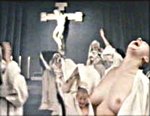
Pure thoughts!
“Benedict attracted many to the new monasteries, and with their increasing numbers and growing influence came the inevitable jealousy and persecution, which culminated with a vile attempt of a neighboring priest to scandalize the monks by an exhibition of naked women, dancing in the courtyard of the saint’s monastery.”
– St. Gregory’s “Dialogues”, 8.
The crime syndicate that exploited and brutalized Europe for a thousand years – otherwise known as Holy Mother Church – was subject to periodic and localized revolt by its slaves from as early as the 10th century (Bogomils, Cathars, Lollards, Hussites, etc.). Across the domains of Christendom the lords of the One True Faith held the common people in subjugation, ignorance and terror. The peasantry’s obligatory devotion, as far as it existed at all, had been reduced to perfunctory conformity and meaningless ritual, chanted in a language they neither spoke nor understood. But the terror was real enough, the terror of imaginary demons and very real killers in the service of the church, the terror of plague and illness, and the terror of frightening levels of infant mortality and hunger. Prior to the 16th century all such movements had been savagely cut down by heresy hunters and crusaders, witch burners and inquisitors.
And then things really warmed up as the religion of gentle Jesus tore Europe apart.
Soon: Europe Ablaze! The bonfire of dissent
Sources:
- Charles Coulombe, Vicars of Christ – A History of the Popes (Citadel, 2003)
- G. Barraclough, The Medieval Papacy (Thames and Hudson, 1979)
- Michael Walsh, The Popes (Querus, 2008)
- Sarah Hopper, To Be A Pilgrim (Sutton, 2002)
- Donald Matthew, Chronicles of the Middle Ages (Angus, 1991)
- Colin McEvedy, The Penguin Atlas of Medieval History (Penguin, 1987)
- James Harpur, Sacred Tracks-2000 Years of Christian Pilgrimage (Frances Lincoln, 2002)
- John Matthews, Bob Stewart, Warriors of Medieval Times (Firebird, 1993)
Related Articles:
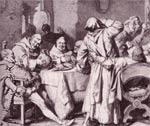
Manly Monks
Monks steady their nerves for Jesus with a little wine.
“A Monk there was, one of the finest sort,
Who rode the country, hunting his sport.
A manly man, to be an Abbot able;
Many a dainty horse he had in stable.
Supple his boots, his horse in fine condition.
He was a prelate fit for exhibition.
He was not pale like a tormented soul.
He liked a fat swan best, and roasted whole.
He let go by the things of yesterday
And took the modern world’s more spacious way.
Poring over books in cloisters? Must be toil
As Austin bade, And till the very soil?
Was he to leave the world upon the shelf?
Let Austin have his labour to himself!
– Geoffrey Chaucer, The Canterbury Tales (1386).
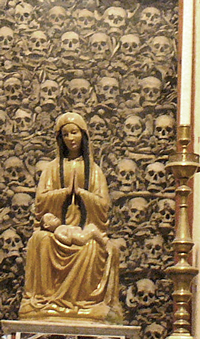
Skulduggery
Even today the dead are used to instill faith and obedience in the living.
The bones of hundreds of “martyrs” tastefully decorate Otranto Cathedral, Italy.

The Racket
Pickled hands and salted heads!
Reading Abbey, a major pilgrimage centre of medieval England, held over 230 “holy relics”
Chief delights were the skull of St. Philip, given to the abbey by King John, and the hand of St James (now in the sacristy of St. Peter’s, Marlow-on-Thames), which was brought to England by Matilda, daughter of Henry I.

Rag and Bone merchants
A now boneless catacomb, Rome.
It has been estimated that during antiquity over six million bodies were interred in the necropolis beneath the city of Rome. The Catholic Church found a good use for this vast stock of deceased humanity.
“Both Willibrond and Boniface went everywhere with chests full of holy relics, bones of saints, which they had collected from Rome. These were the lucky charms which would replace ancient superstition.”
– B. Gascoigne, A Brief History of Christianity, p42.
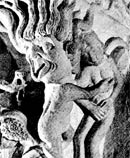
Psycho-terror
Groping demon, Vézelay.
The threat of being withheld from the “eternal life” of Christ was backed up the graphic torments of hell.
Who could hold out against such psycho-terrorism?
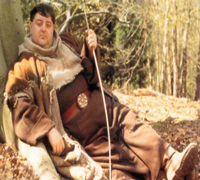
The Rackets
Parasites of Salvation
Born a sinner, a man could earn redemption as a criminal in the service of the Church.
“There was a Friar, a wanton and of merry hope
He had a special license from the Pope.
Sweetly he heard his penitents as shrift
With pleasant absolution, for a gift.
He was an easy man in penance giving
Where he could hope to make a decent living
But strong enough to butt a bruiser down
He knew the taverns well in every town.
And every innkeeper and barmaid too
Better than lepers, beggars and that crew.
For though a widow mightn’t have a shoe
So pleasant was his holy how-d’ye-do.
He got his farthing from her just the same
Before he left, and so his income came.”
– Geoffrey Chaucer, The Canterbury Tales (1386).

The Original Terrorists for God
Having criminalized humanity through the doctrine of sin – and all were sinners from the moment of birth – the Church was able to harness the guilt which sin engendered for its own purposes.
The political use of penance – for example, as an alternative to prison – allowed the sinner to redeem himself by military or other service to the Church.
Military orders proliferated: the ‘Hospitallers’ and ‘Templars’, the Knights of Santiago, the Knights of Alcantara, the Knights of Calatrava, etc.
The military orders grew rich on gifts and land although there was intense rivalry between these ‘corporations’ for sinecures, patronage and gifts.
